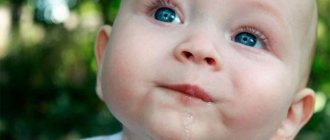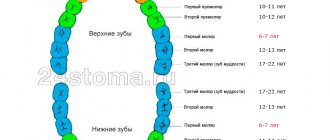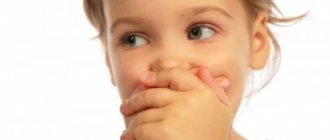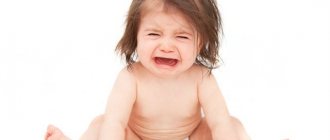Development of teeth before eruption
The health of your baby’s teeth needs to be taken care of long before they erupt. It is useful for expectant mothers to know that the rudiments of baby teeth are formed already at the 7-8th week of intrauterine development, and permanent ones - at the end of 4 months. Not only the timing of teething, but even the level of mineralization of the enamel of both milk and molars depends on how pregnancy proceeds. Therefore, it is so critical that a woman receives all the vitamins and microelements and is as healthy as possible.
But it’s not just nutrition that’s important. Research results have shown that in the presence of industrial harmful substances in the environment of the expectant mother during pregnancy and numerous stressful situations, the formation of all dental tissues in the child is disrupted and the timing of the appearance of baby teeth is shifted. Among children born to women with high blood pressure, late eruption of primary teeth was observed in 56.7%. In approximately a third of the examined children born to mothers with heart defects, late eruption of primary teeth was detected, as well as deviations in the pairing and sequence of their eruption. The length of pregnancy also plays a role. There is a pronounced dependence of the timing of the eruption of the first teeth on the degree of prematurity: the earlier the baby is born, the later the first teeth erupt [1, 2].
When do the first teeth appear?
Most often, the first milk chewing organ appears at 4-7 months. Mothers notice symptoms before active growth in advance, from 3 months. The generally accepted timing of the birth of rudiments is arbitrary. Minor deviations from them are normal and should not bother moms and dads. After all, the rudiments of future teeth in newborns are formed long before their appearance, even in the mother’s womb. Many experts believe that the process depends on genetic predisposition. Prevention of caries in children is very important. Although some adults mistakenly believe that temporary rudiments do not need to be treated, as they will fall out.
There should be 20 milk units. The order of their appearance according to the generally accepted scheme is as follows:
- First, the lower first incisors make their way through the gums. They are also called medial.
- Then the upper first incisors appear.
- After them, the upper second incisors grow, and then the lower second incisors, which are called lateral incisors.
- Next, the upper first molars are shown on the surface of the mucous membranes, and then their lower antagonists.
- Only then do the upper and lower fangs grow.
- The lower second molars appear last, followed by their upper antagonists.
The timing and priority may not coincide with the generally accepted schedule. Relatives, of course, should monitor this process, but there is no need to panic. All controversial issues should be resolved with a pediatrician and pediatric dentist. It is important to remain calm and patient so as not to create conditions for a stressful situation that will negatively affect the baby’s health.
Why are baby teeth needed?
Nature has designed the correct order and timing of teething in children. Evolutionarily, this is due to the need to form the bite and jaw bones for chewing and speech. Over the years, the bones grow, and baby teeth, which at the beginning of their appearance were tightly adjacent to each other, diverge by the age of 6-7 years, forming wide interdental spaces that are natural for this period - tremata and diastemas.
There are only 20 teeth in the primary dentition. This is explained by the fact that they must be correctly placed in the small child’s jaw in the first years of the baby’s life, and eliminates the crowding of teeth that provokes dental diseases. The last of the baby teeth are replaced at the age of 10-12 years. However, they are very important for the physiological formation of the jaw bones and the permanent bite.
Proper growth and health of baby teeth helps:
- rebuild the body from lactophoric to mixed type of nutrition;
- reserve space for the normal location of future molars;
- form a mixed bite.
There is a misconception that if baby teeth become infected with caries, they can not be treated, but can be removed immediately. But modern dentists are against such tactics. Early removal is fraught with displacement of adjacent baby teeth and the appearance of problems with an adult bite. Therefore, it is so important to maintain the presence and health of all baby teeth until the permanent teeth erupt on their own [3].
How teeth are cut: the order in which they appear
Every adult can understand how a baby feels when his first teeth are cut - just remember how the so-called “wisdom teeth” appeared.
Swelling of the gums, itching and pain - you must admit, this is not pleasant. Therefore, infants often become capricious during the teething process. They may lose appetite and sleep, and even have a slight rise in temperature. The earliest time for baby teeth to erupt is at the incisors (front teeth). There are four of them on each jaw. As a rule, the lower two incisors erupt first (at 6-8 months), then the upper central incisors. The teeth appear in pairs opposite to each other, this is important for the formation of a correct primary bite. At 8-12 months, the baby develops lateral incisors (first on the lower jaw, then on the upper). At one year old, a child should have eight teeth. After this there is a short break in their appearance.
Next in the sequence are fangs. There are two of them on each jaw. The location and structure of these teeth makes their eruption especially difficult and difficult for the child. At the age of 16-20 months, fangs will appear on the lower jaw, and then on the upper jaw. Then comes the turn of the painters (large molars). They begin to erupt at 20-30 months, each child at its own time. There are a total of 20 teeth in the primary occlusion, 10 on each jaw: 4 incisors, 2 canines and 4 painters. All of them should appear by 2.5-3 years.
Timing of baby teeth eruption
Teething is a genetically programmed event that occurs at a certain period.
Physiological teething is characterized by three main features: certain timing, pairing and sequence of eruption “Characteristics of exogenous and endogenous factors influencing the eruption of primary teeth in children” Dr. med. Galaktionova M. Yu.
Children's baby teething rates vary depending on their ethnicity. But as research shows, in general, in the world there is a reduction in the time from birth to the moment when the first tooth appears. This is due, according to most researchers, to the global acceleration of human development [1]. How and when baby teeth erupt is one of the indicators of a child’s physical development.
The reasons for violation of the order and timing of teething in children can be:
- heredity;
- climatic conditions;
- nature of feeding;
- some diseases, for example, rickets.
The standards for the eruption of primary teeth according to the American Dental Association are presented in the table.
| Baby teeth | Upper jaw eruption / month. | Lower jaw eruption / month. |
| Central incisor | 8-12 | 6-10 |
| Lateral incisor | 9-13 | 10-16 |
| Fang | 16-22 | 17-23 |
| First molar | 13-19 | 14-18 |
| Second molar | 25-33 | 23-31 |
The indicated periods are average indicators, varying depending on individual and family characteristics [4,5]. But the sequence of appearance of teeth is significant, and it is better to track and record it. From a physiological point of view, the correct order of eruption of baby teeth in children is important for the formation of occlusion .
Helping your baby with teething
The appearance of baby teeth is not an easy process not only for the children themselves, but also for their parents. The most common symptoms of teething:
- swelling and redness of the gums;
- increased salivation;
- itching and desire to keep hands and toys in the mouth;
- child's capriciousness;
- sleep disturbance;
- refusal to breastfeed, bottle or complementary foods;
- temperature increase;
- bowel disorders;
- runny nose.
The following will help you get through this period as comfortably as possible:
- special teething rings that relieve itching, especially with a cooling effect;
- dental gels with local anesthetic effect;
- antipyretic and painkillers;
light massage with a silicone fingertip, which will bring relief and calm the baby [6]
Pathological signs: when should you see a doctor?
Some symptoms that young mothers consider normal during teething are not directly related to the process and are the penetration of infection into the child’s body. Teething is stressful for the body, and the child’s immunity during this period is greatly weakened, which creates excellent conditions for the growth of pathogenic bacteria and viruses.
Listed below are typical signs that require consultation with a specialist, which cannot be considered as a physiological norm during the appearance of baby teeth in infants.
- Temperature . A slight increase in temperature is considered normal during the eruption of frontal incisors and canines, but it should not rise above the upper limits of subfebrility. If a child has a temperature of 38.1°C or higher, you should consult a doctor - an infection has probably occurred due to reduced immunity.
- Diarrhea. It is normal to loosen stools due to increased activity of the endocrine glands, but stools should not be too frequent, watery, or foul-smelling. There should be no changes in the color of the stool, so consultation with a doctor is necessary if the stool has changed consistency, color or smell.
- Cough . The physiological norm is a slight cough that occurs as a result of saliva flowing down the back wall of the larynx, but a frequent and prolonged cough always indicates a cold infection.
Any changes in the child’s well-being and behavior should be a reason for consultation with a pediatrician or pediatric dentist - only a doctor will be able to assess the baby’s condition and draw a conclusion about his health and the need for any therapy. Read the article for treatment of stomatitis at home.
Caring for baby teeth
As soon as your first tooth comes through, don’t put off going to the dentist. Make a schedule of visits (at least once every 3-4 months). And after the first birthday, it is advisable to also see an orthodontist. If there are no problems, visits to him should be repeated once a year [7,8]
It is important to provide proper care at home.
- An ultra-soft toothbrush with a small head is suitable for baby teeth
- Children's mouth rinses are used from about 4 years of age or from the time the child learns to spit out liquid.
- Parents should supervise the brushing of preschool children's teeth and, if necessary, help and finish cleaning missed areas.
- Adults need to teach their child to rinse their mouth after eating from a very early age.
- Until the child has learned to spit on his own, toothpaste should not contain fluoride.
- A timer in the bathroom or a favorite song helps you keep your teeth brushing to 2 minutes.
- Solid food should be included in the diet daily in sufficient quantities to properly form the bite and stimulate the gums.
These simple recommendations help maintain the health of baby teeth from the very beginning until their natural replacement with permanent ones.











